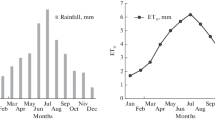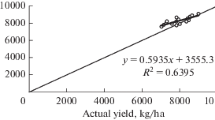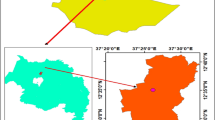Abstract
Research on field water consumption is critical for optimizing crop growth and policy-making, in which the computer models play an increasingly important role. As a water-driven crop model, the AquaCrop model has been used in a large number of studies since its launch in 2009. However, how the model performs in predicting the ecohydrological process of farmland under film-mulched drip irrigation is still unclear, especially its application on partitioning crop evapotranspiration is very rarely reported. To make up for the above insufficiency, maize experiments were conducted under full mulch drip irrigation with observation instruments of eddy covariance systems, heat balance stem-flow gauges, micro-lysimeters and other tools, during seasons of 2014–2018. The AquaCrop model was first calibrated using measured data in 2014, and subsequently validated with data in 2015–2018. Results indicate that the parameterized model could precisely simulate the canopy cover (\({R}^{2}\) = 0.97), biomass (\({R}^{2}\) = 0.99) and grain yield (standard deviation was 4.13%), as well as reflect the patterns of daily variation in transpiration and evapotranspiration with satisfactory \({R}^{2}\) of 0.91 and 0.87, respectively. Nevertheless, the \({R}^{2}\) values of soil water content and evaporation were not good, ranging between 0.23 and 0.45, and 0.26 and 0.75, respectively. The AquaCrop model adopts canopy cover instead of leaf area index to describe the growing process of crops; this is an important innovation for model extension and application but also may lead to some inaccuracies in water balance simulation. Summarizing, this study shows that the AquaCrop model is appropriate for supporting crop production but not for predicting the soil moisture content and evaporation variation for maize under film-mulching drip irrigation.







Similar content being viewed by others
References
Abdalhi MAM, Jia ZH (2018) Crop yield and water saving potential for AquaCrop model under full and deficit irrigation managements. Ital J Agron 13:267–278
Abrha B, Delbecque N, Raes D, Tsegay A, Todorovic M, Heng LK, Vanutrecht E, Geerts S, Garciavila M, Deckers S (2012) Sowing strategies for barley (Hordeum vulgare L.) based on modelled yield response to water with AquaCrop. Exp Agr 48:252–271
Allen RG, Pereira LS, Raes D, Smith M (1998) Crop evapotranspiration—guidelines for computing crop water requirements. FAO irrigation and Drainage Paper 56, Rome
Allen RG, Pereira LS, Smith M, Raes D, Wright JL (2005) FAO-56 Dual crop coefficient method for estimating evaporation from soil and application extensions. J Irrig Drain 131:2–13
Araya A, Habtu S, Hadgu KM, Kebede A, Dejene T (2010) Test of AquaCrop model in simulating biomass and yield of water deficient and irrigated barley (Hordeum vulgare). Agr Water Manage 97:1838–1846
Babel MS, Deb P, Soni P (2019) Performance evaluation of AquaCrop and DSSAT-CERES for maize under different irrigation and manure application rates in the Himalayan region of India. Agr Res 8:207–217
Bannayan M, Hoogenboom G (2009) Using pattern recognition for estimating cultivar coefficients of a crop simulation model. Field Crops Res 111:290–302
Belay AT, Patil RH (2017) Evaluation of DSSAT-CERES maize model for northern transitional zone of Karnataka. J Agric Res Technol 42:036–043
Castañeda A, Leffelaar PA, Álvaro-Fuentes J, Cantero-Martínez C, Minguez MI (2015) Selecting crop models for decision making in wheat insurance. Eur J Agron 68:97–116
Deb P, Shrestha S, Babel MS (2015) Forecasting climate change impacts and evaluation of adaptation options for maize cropping in the hilly terrain of Himalayas: Sikkim, India. Theor Appl Climatol 121:649–667
Ding RS, Kang SZ, Zhang YQ, Hao XM, Tong L, Du TS (2013) Partitioning evapotranspiration into soil evaporation and transpiration using a modified dual crop coefficient model in irrigated maize field with ground-mulching. Agr Water Manage 127:85–96
Du WY, He XK, Shamaila Z, Hu ZF, Zeng AJ, Muller J (2011) Yield and biomass prediction testing of AquaCrop model for winter wheat. TCSAM 42:174–178 (in Chinese)
Eisenhauer JG (2003) Regression through the origin. Teach Stat 25:76–80
Falge E, Baldocchi DD, Olson R, Anthoni P, Aubinet M, Bernhofer C, Burba G, Ceulemans R, Clement R, Dolman H, Granier A, Gross P, Grunwald T, Hollinger D, Jensen NO, Katul G, Keronen P, Kowalski A, Ta Lai C, Law BE, Meyers T, Moncrieff J, Moors E, Munger JW, Pilegaard K, Rannik U, Rebmann C, Suyker A, Tenhunen J, Tu K, Verma S, Vesala T, Wilson K, Wofsy S (2001) Gap filling strategies for long term energy flux data sets. Agric For Meteorol 107:71–77
Farahani HJ, Izzi G, Oweis TY (2009) Parameterization and evaluation of the AquaCrop model for full and deficit irrigated cotton. Agron J 101:469–476
Finnigan JJ, Clement R, Malhi Y, Leuning R, Cleugh HA (2003) Re-evaluation of long-term flux measurement techniques. Part I: averaging and coordinate rotation. Bound Layer Meteorol 107:1–48
García-Vila M, Fereres E (2012) Combining the simulation crop model AquaCrop with an economic model for the optimization of irrigation management at farm level. Eur J Agron 36:21–31
García-Vila M, Fereres E, Mateos L, Orgaz F, Steduto P (2009) Deficit irrigation optimization of cotton with AquaCrop. Agron J 101:477–487
Geerts S, Raes D, Garcia M, Taboada C, Miranda R, Cusicanqui J, Mhizha T, Vacher J (2009) Modeling the potential for closing quinoa yield gaps under varying water availability in the Bolivian Altiplano. Agr Water Manage 96:1652–1658
Ham JM, Heilman JL (1990) Dynamics of a heat balance stem flow gauge during high flow. Agron J 82:147–152
He QS, Li SE, Kang SZ, Yang HB, Qin SJ (2018) Simulation of water balance in a maize field under film-mulching drip irrigation. Agr Water Manage 210:252–260
Heng LK, Hsiao T, Evett S, Howell TA, Steduto P (2009) Validating the FAO AquaCrop model for irrigated and water deficient field maize. Agron J 101:488–498
Hsiao TC, Heng LK, Steduto P, Rojas-Lara B, Raes D, Fereres E (2009) AquaCrop-the FAO crop model to simulate yield response to water: III. Parameterization and testing for maize. Agron J 101:448–459
Jin XL, Feng HK, Zhu XK, Li ZH, Song SN, Song XY, Yang GJ, Xu XG, Guo WS (2014) Assessment of the AquaCrop model for use in simulation of irrigated winter wheat canopy cover, biomass, and grain yield in the North China Plain. PLoS ONE 9:e86938
Katerji N, Campi P, Mastrorilli M (2013) Productivity, evapotranspiration, and water use efficiency of corn and tomato crops simulated by AquaCrop under contrasting water stress conditions in the Mediterranean region. Agr Water Manage 130:14–26
Kumar P, Sarangi A, Singh DK, Parihar SS (2015) Evaluation of AquaCrop model in predicting wheat yield and water productivity under irrigated saline regimes. Irrig Drain 63:474–487
Lorite IJ, García-Vila M, Santos C, Ruiz-Ramosc M, Fereresb E (2013) AquaData and AquaGIS: two computer utilities for temporal and spatial simulations of water-limited yield with AquaCrop. Comput Electron Agr 96:227–237
Mainuddin M, Kirby M, Hoanh CT (2011) Adaptation to climate change for food security in the lower Mekong Basin. Food Security 3:433–450
Nash JE, Sutcliffe JV (1970) River flow forecasting through conceptual models part I—a discussion of principles. J Hydrol 10:282–290
Paredes P, Melo-Abreu JPD, Alves I, Pereira LS (2014) Assessing the performance of the FAO AquaCrop model to estimate maize yields and water use under full and deficit irrigation with focus on model parameterization. Agr Water Manage 144:81–97
Paredes P, Wei Z, Liu Y, Xu D, Xin Y, Zhang B, Pereira LS (2015) Performance assessment of the FAO AquaCrop model for soil water, soil evaporation, biomass and yield of soybeans in North China Plain. Agr Water Manage 152:57–71
Paw KTU, Baldocchi DD, Meyers TP, Wilson KB (2000) Correction of eddy-covariance measurements incorporating both advective effects and density fluxes. Bound Layer Meteorol 97:487–511
Pereira LS, Paredes P, Rodrigues GC, Neves MM (2015) Modeling malt barley water use and evapotranspiration partitioning in two contrasting rainfall years. Assessing AquaCrop and SIMDualKc models. Agr Water Manage 159:239–254
Qin SJ, Li SE, Kang SZ, Du TS, Tong L, Ding RS, Wang YH, Guo H (2019) Transpiration of female and male parents of seed maize in northwest China. Agr Water Manage 213:397–409
Raes D, Steduto P, Hsiao TC, Fereres E (2009a) AquaCrop—the FAO crop model to simulate yield response to water: II. Main algorithms and software description. Agron J 101:438–447
Raes D, Steduto P, Hsiao TC, Fereres E (2009b) AquaCrop—the FAO crop model to simulate yield response to water: reference manual annexes. Available from: https://www.fao.org/nr/water/aquacrop.html
Raes D, Steduto P, Hsiao T, Fereres E (2012) AquaCrop Version 4.0. ReferenceManual. FAO, Land and Water Division, Rome, Italy
Ran H, Kang SZ, Li FS, Tong L, Ding RS, Du TS, Li SE, Zhang XT (2017) Performance of AquaCrop and SIMDualKc models in evapotranspiration partitioning on full and deficit irrigated maize for seed production under plastic film-mulch in an arid region of China. Agr Syst 151:20–32
Ran H, Kang SZ, Li FS, Du TS, Tong L, Li SE, Ding RS (2018) Parameterization of the AquaCrop model for full and deficit irrigated maize for seed production in arid Northwest China. Agr Water Manage 203:438–450
Rosa RD, Paredes P, Rodrigues GC, Alves I, Fernando RM, Pereira LS, Allen RG (2012) Implementing the dual crop coefficient approach in interactive software: 1. Background and computational strategy. Agric Water Manage 103:8–24
Saab MTA, Todorovic M, Albrizio R (2015) Comparing AquaCrop and CropSyst models in simulating barley growth and yield under different water and nitrogen regimes. Does calibration year influence the performance of crop growth models? Agr Water Manage 147:21–33
Sakuratani T (1981) A heat balance method for measuring water flux in the stem of intact plants. J Agric Meteorol 37:9–17
Shen QX, Ding RS, Du TS, Tong L, Li SE (2019) Water use effectiveness is enhanced using film mulch through increasing transpiration and decreasing evapotranspiration. Water 11:1153
Steduto P, Hsiao TC, Raes D, Fereres E (2009) AquaCrop—The FAO crop model to simulate yield response to water: I. Concepts and underlying principles. Agron J 101:426–437
Todorovic M, Albrizio R, Zivotic L, Saab MTA, Stockle C, Steduto P (2009) Assessment of AquaCrop, CropSyst, and WOFOST models in the simulation of sunflower growth under different water regimes. Agron J 101:509–521
Toumi J, Er-Raki S, Ezzahar J, Khabba S, Jarlan L, Chehbouni A (2016) Performance assessment of AquaCrop model for estimating evapotranspiration, soil water content and grain yield of winter wheat in Tensift Al Haouz (Morocco): application to irrigation management. Agr Water Manage 163:219–235
Twine TE, Kustas WP, Norman JM, Cook DR, Houser PR, Meyers TP, Prueger JH, Starks PJ, Wesely ML (2000) Correcting eddy-covariance flux underestimates over a grassland. Agric For Meteorol 103:279–300
Vanuytrecht E, Raes D, Willems P (2011) Considering sink strength to model crop production under elevated atmospheric CO2. Agric For Meteorol 151:1753–1762
Vanuytrecht E, Raes D, Steduto P, Hsiao TC, Fereres E, Heng LK, Vila MG, Moreno PM (2014) AquaCrop: FAO’s crop water productivity and yield response model. Environ Model Softw 62:351–360
Wang XX, Wang QJ, Fan J, Fu QP (2013) Evaluation of the AquaCrop model for simulating the impact of water deficits and different irrigation regimes on the biomass and yield of winter wheat grown on China’s Loess Plateau. Agr Water Manage 129:95–104
Webb EK, Pearman GI, Leuning R (1980) Correction of flux measurements for density effects due to heat and water vapor transfer. Q J R Meteor Soc 106:85–100
Wei Z, Paredes P, Liu Y, Chi WW, Pereira LS (2015) Modelling transpiration, soil evaporation and yield prediction of soybean in North China Plain. Agr Water Manage 147:43–53
Willmott CJ (1984) On the evaluation of model performance in physical geography. In: Gaile GL, Willmott CJ (eds) Spatial statistics and models, vol 40. Springer, Dordrecht, pp 443–460
Yang N, Sun ZC, Zhang LZ, Zheng JN, Feng L, Li K, Zhang Z, Feng C (2015) Simulation of water use process by film mulched cultivated maize based on improved AquaCrop model and its verification. TCSAE 31:122–132 (in Chinese)
Zeleke KT, Luckett D, Cowley R (2011) Calibration and testing of the FAO AquaCrop model for Canola. Agron J 103:1610–1618
Zhao NN, Yu L, Cai JB, Paredes P, Rosa RD, Pereira LS (2013) Dual crop coefficient modelling applied to the winter wheat-summer maize crop sequence in North China Plain: basal crop coefficients and soil evaporation component. Agr Water Manage 117:93–105
Zhao Y, Mao XM, Bo LY (2018) Simulation of soil moisture dynamics and seed-maize growth under different mulching and irrigation conditions. TCSAE 49:195–204 (in Chinese)
Acknowledgements
We greatly appreciate the careful and precise reviews by the anonymous reviewers. They paid great efforts on improving the manuscript and study. This work was financially supported by the National Key Research and Development Program of China (2016YFC0400201), and Chinese National Natural Science Fund (51622907, 51879262).
Author information
Authors and Affiliations
Corresponding authors
Ethics declarations
Conflict of interest
Authors have no conflict of interest to declare.
Additional information
Publisher's Note
Springer Nature remains neutral with regard to jurisdictional claims in published maps and institutional affiliations.
Rights and permissions
About this article
Cite this article
He, Q., Li, S., Hu, D. et al. Performance assessment of the AquaCrop model for film-mulched maize with full drip irrigation in Northwest China. Irrig Sci 39, 277–292 (2021). https://doi.org/10.1007/s00271-020-00705-z
Received:
Accepted:
Published:
Issue Date:
DOI: https://doi.org/10.1007/s00271-020-00705-z




